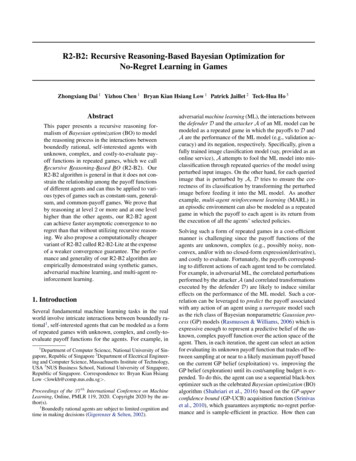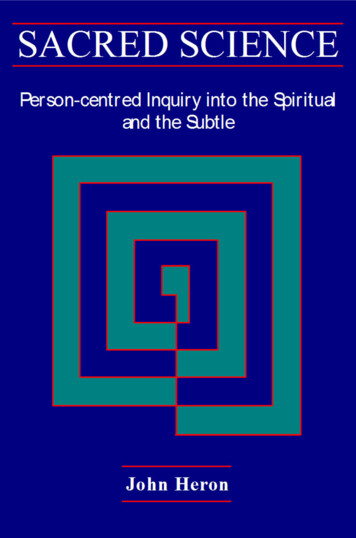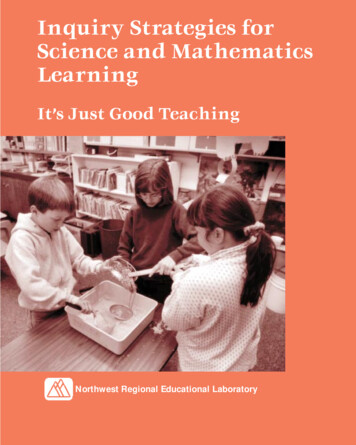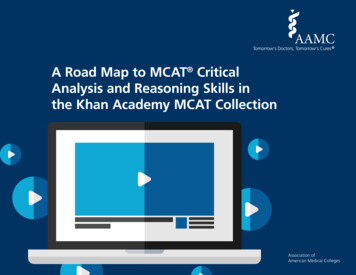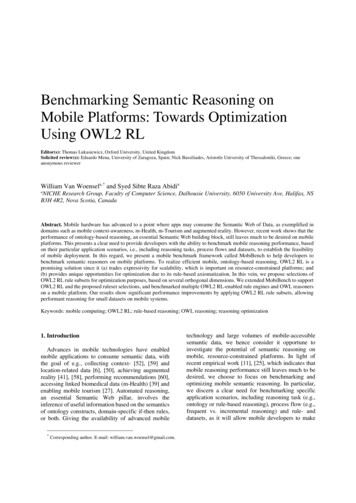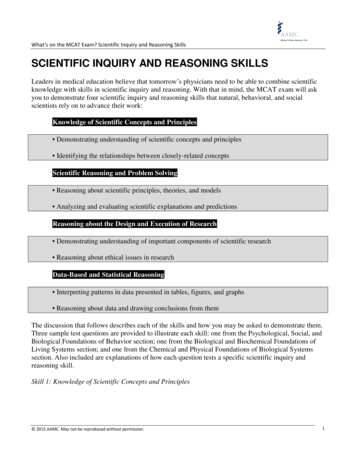
Transcription
What’s on the MCAT Exam? Scientific Inquiry and Reasoning SkillsSCIENTIFIC INQUIRY AND REASONING SKILLSLeaders in medical education believe that tomorrow’s physicians need to be able to combine scientificknowledge with skills in scientific inquiry and reasoning. With that in mind, the MCAT exam will askyou to demonstrate four scientific inquiry and reasoning skills that natural, behavioral, and socialscientists rely on to advance their work:Knowledge of Scientific Concepts and Principles Demonstrating understanding of scientific concepts and principles Identifying the relationships between closely-related conceptsScientific Reasoning and Problem Solving Reasoning about scientific principles, theories, and models Analyzing and evaluating scientific explanations and predictionsReasoning about the Design and Execution of Research Demonstrating understanding of important components of scientific research Reasoning about ethical issues in researchData-Based and Statistical Reasoning Interpreting patterns in data presented in tables, figures, and graphs Reasoning about data and drawing conclusions from themThe discussion that follows describes each of the skills and how you may be asked to demonstrate them.Three sample test questions are provided to illustrate each skill: one from the Psychological, Social, andBiological Foundations of Behavior section; one from the Biological and Biochemical Foundations ofLiving Systems section; and one from the Chemical and Physical Foundations of Biological Systemssection. Also included are explanations of how each question tests a specific scientific inquiry andreasoning skill.Skill 1: Knowledge of Scientific Concepts and Principles 2015 AAMC. May not be reproduced without permission.1
What’s on the MCAT Exam? Scientific Inquiry and Reasoning SkillsThe questions in this skill category will ask you to demonstrate your knowledge of the 10 foundationalconcepts described earlier in this chapter. These questions will ask you to recognize, recall, or definebasic concepts in the natural, behavioral, and social sciences as well as their relationships with oneanother. The concepts and scientific principles may be represented by words, graphs, tables, diagrams,or formulas.As you work on these questions, you may be asked to recognize a scientific fact or define a concept. Oryou may be asked to apply a scientific principle to a problem. Questions may ask you to identify therelationships between closely-related concepts or relate verbal to graphic representations of sciencecontent. They may ask you to identify examples of observations that illustrate scientific principles.Questions may ask you to recognize a scientific concept shown in a diagram or represented in a graph.Or they may give you a mathematical equation and ask you to use it to solve a problem.Questions that test this skill will ask you to show that you understand scientific concepts and principlesby, for example, Recognizing correct scientific principles Identifying the relationships among closely-related concepts Identifying the relationships between different representations of concepts (e.g., verbal,symbolic, graphic) Identifying examples of observations that illustrate scientific principles Using mathematical equations to solve problemsBy way of example, questions from the Psychological, Social, and Biological Foundations of Behaviorsection may ask you to demonstrate your knowledge of scientific concepts and principles by Recognizing the principle of retroactive interference Using Weber’s Law to identify physical differences that are detectableIdentifying the behavioral change (extinction) that will occur when a learned response is nolonger followed by a reinforcer Identifying the relationship between operant conditioning and classical conditioning Identifying a graph that illustrates the relationship between educational attainment and lifeexpectancy Recognizing conditions that result in learned helplessness Recognizing a demographic trend that is represented in a population pyramidThe three sample questions that follow illustrate Skill 1 questions from, respectively, the Psychological,Social, and Biological Foundations of Behavior section; the Biological and Biochemical Foundations ofLiving Systems section; and the Chemical and Physical Foundations of Biological System section of theMCAT exam. 2015 AAMC. May not be reproduced without permission.2
What’s on the MCAT Exam? Scientific Inquiry and Reasoning SkillsSKILL 1 EXAMPLE FROM THE PSYCHOLOGICAL, SOCIAL, AND BIOLOGICAL FOUNDATIONS OFBEHAVIOR SECTION:Which series correctly sequences the types of cells involved in the transmission of information fromsound detection to the moment when an individual turns his or her head in response to the sound?A.B.C.D.Sensory neurons, interneurons, afferent neurons, skeletal muscle cellsSensory neurons, efferent neurons, interneurons, skeletal muscle cellsMechanoreceptors, sensory neurons, interneurons, motor neurons, skeletal muscle cellsMechanoreceptors, sensory neurons, interneurons, afferent neurons, skeletal muscle cellsThe correct answer is C. This Skill 1 question tests your knowledge of the scientific concepts andprinciples described by Content Category 6A, Sensing the environment, and is a Skill 1 question becauseit requires you to relate scientific concepts. This question asks you to recognize and sequence the correctorder of receptors and neurons involved in sensory processing and to conclude that C is the correctanswer.SKILL 1 EXAMPLE FROM THE BIOLOGICAL AND BIOCHEMICAL FOUNDATIONS OF LIVING SYSTEMSSECTION:How are the basal layer of the epidermis and the innermost lining of the small intestine similar?A.B.C.D.Both are nondividing tissues.Both are derived from ectoderm.Both are composed of squamous cells.The cells of both are connected by tight junctions.The correct answer is D. It is a Skill 1 question and assesses knowledge of Content Category 2A,Assemblies of molecules, cells, and groups of cells within singular cellular and multicellular organisms.It is a Skill 1 question because it requires you to recall the structural and embryological characteristics oftwo tissues and relate them to one another. To answer this question correctly, you must identify asimilarity between the basal layer of the epidermis and the innermost lining of the small intestine.SKILL 1 EXAMPLE FROM THE CHEMICAL AND PHYSICAL FOUNDATIONS OF BIOLOGICAL SYSTEMSSECTION:In Michaelis-Menten enzyme kinetics, what is the velocity of the reaction when the substrateconcentration is equal to KM?A.B.C.D.¼Vmax½VmaxVmax2Vmax 2015 AAMC. May not be reproduced without permission.3
What’s on the MCAT Exam? Scientific Inquiry and Reasoning SkillsThe correct answer is B. This is a Skill 1 question and relates to Content Category 5E, Principles ofchemical thermodynamics and kinetics. It is a Skill 1 question because you must recognize therelationship between two variables in the context of an experiment. To answer the question, you mustrecognize KM, recall its significance in Michaelis-Menten enzyme kinetics, and relate it to anotherfundamental variable, Vmax.Skill 2: Scientific Reasoning and Problem SolvingQuestions that test scientific reasoning and problem-solving skills differ from questions in the previouscategory by asking you to use your scientific knowledge to solve problems in the natural, behavioral,and social sciences.As you work on questions that test this skill, you may be asked to use scientific theories to explainobservations or make predictions about natural or social phenomena. Questions may ask you to judgethe credibility of scientific explanations or to evaluate arguments about cause and effect. Or they mayask you to use scientific models and observations to draw conclusions. They may ask you to recognizescientific findings that call a theory or model into question. Questions in this category may ask you tolook at pictures or diagrams and draw conclusions from them. Or they may ask you to determine andthen use scientific formulas to solve problems.You will be asked to show that you can use scientific principles to solve problems by, for example, Reasoning about scientific principles, theories, and models Analyzing and evaluating scientific explanations and predictions Evaluating arguments about causes and consequences Bringing together theory, observations, and evidence to draw conclusions Recognizing scientific findings that challenge or invalidate a scientific theory or model Determining and using scientific formulas to solve problemsBy way of illustration, questions from the Psychological, Social, and Biological Foundations ofBehavior section may ask you demonstrate this skill by Using the main premises of symbolic interactionism to reason about an observational study ofphysician-patient interactions Predicting how an individual will react to cognitive dissonance Reasoning about whether a causal explanation is possible when given an example of howsomebody’s gender or personality predicts his or her behavior Concluding which stage of cognitive development a child is in, according to Piaget’s theory,when presented with a description of how a child responds to a conservation problem Determining whether an example, such as when an anorexic teenager restricts eating to satisfyesteem needs, is compatible with the premises of Maslow’s hierarchy of needs 2015 AAMC. May not be reproduced without permission.4
What’s on the MCAT Exam? Scientific Inquiry and Reasoning Skills Drawing a conclusion about which sociological theory would be most consistent with aconceptual diagram that explains how social and environmental factors influence health Identifying the relationship between social institutions that is suggested by an illustration used ina public health campaignFor more context, let’s consider three Skill 2 questions linked to different foundational concepts in thePsychological, Social, and Biological Foundations of Behavior section; the Biological and BiochemicalFoundations of Living Systems section; and the Chemical and Physical Foundations of BiologicalSystems section.SKILL 2 EXAMPLE FROM THE PSYCHOLOGICAL, SOCIAL, AND BIOLOGICAL FOUNDATIONS OFBEHAVIOR SECTION:The concept of cultural capital predicts that:A. cultural distinctions associated with the young will be more valued within a society.B. with improved communication, there will eventually be a convergence of cultural practices of allclasses.C. cultural distinctions by class will become less important during a recession because people willhave less money to spend.D. cultural distinctions associated with elite classes will be more valued within a society.The correct answer is D. It is a Skill 2 question and assesses knowledge of Content Category 10A,Social inequality. It is a Skill 2 question because it requires you to make a prediction based on aparticular concept. This question requires you to understand the concept of cultural capital in order toevaluate which prediction about social stratification would be most consistent with the concept.SKILL 2 EXAMPLE FROM THE BIOLOGICAL AND BIOCHEMICAL FOUNDATIONS OF LIVING SYSTEMSSECTION:Starting with the translation initiation codon, the following sequence encodes a polypeptide of howmany amino acids?5'-CUGCCAAUGUGCUAAUCGCGGGGG-3'A.B.C.D.2368 2015 AAMC. May not be reproduced without permission.5
What’s on the MCAT Exam? Scientific Inquiry and Reasoning SkillsThe correct answer is A. This is a Skill 2 question, and you must use knowledge from Content Category1B, Transmission of genetic information from the gene to the protein, to solve this problem. In additionto recalling the sequence for the start codon, this is a Skill 2 question because it requires you to apply thescientific principle of the genetic code to the provided RNA sequence. As a Skill 2 question, reasoningabout the role of the stop codon in translation will allow you to arrive at the conclusion that thispolypeptide has two amino acids.SKILL 2 EXAMPLE FROM THE CHEMICAL AND PHYSICAL FOUNDATIONS OF BIOLOGICAL SYSTEMSSECTION:The radius of the aorta is about 1.0 cm and blood passes through it at a velocity of 30 cm/s. A typicalcapillary has a radius of about 4 10–4 cm with blood passing through at a velocity of 5 10–2 cm/s.Using this data, what is the approximate number of capillaries in a human body?A.B.C.D.1 1042 1074 1097 1012The correct answer is C. This Skill 2 question relates to Content Category 4B, Importance of fluids forthe circulation of blood, gas movement, and gas exchange. This question asks you to use a mathematicalmodel to make predictions about natural phenomena. To answer this question, you must be able torecognize the principles of flow characteristics of blood in the human body and apply the appropriatemathematical model to an unfamiliar scenario. Answering this question first requires recognition that thevolume of blood flowing through the aorta is the same volume of blood flowing through the capillaries.It is a Skill 2 question because you then need to use reasoning skills to find the difference in the volumesthat the aorta and capillaries can each carry in order to calculate the total number of capillaries.Skill 3: Reasoning about the Design and Execution of ResearchQuestions that test reasoning about the design and execution of research will ask you to demonstrateyour scientific inquiry skills by showing that you can “do” science. They will ask you to demonstrateyour understanding of important components of scientific methodology. These questions will ask you todemonstrate your knowledge of the ways in which natural, behavioral, and social scientists conductresearch to test and extend scientific knowledge.As you work on these questions, you may be asked to show how scientists use theory, past researchfindings, and observations to ask testable questions and pose hypotheses. Questions that test this skillmay ask you to reason about the ways in which scientists gather data from samples of members of thepopulation about which they would like to draw inferences. They may ask you to identify how scientistsmanipulate and control variables to test their hypotheses. Questions may ask you to reason about theways scientists take measurements and record results. These questions may ask you to recognize faultyresearch logic or point out the limitations of the research studies that are described. Or they may ask youto identify factors that might confuse the inferences you can draw from the results. 2015 AAMC. May not be reproduced without permission.6
What’s on the MCAT Exam? Scientific Inquiry and Reasoning SkillsThese questions may also ask you to demonstrate and use your understanding of the ways scientistsadhere to ethical guidelines to protect the rights of research participants, the integrity of their work, andthe interests of research consumers.Questions that test this skill will ask you to use your knowledge of important components of scientificmethodology by, for example, Identifying the role of theory, past findings, and observations in scientific questioning Identifying testable research questions and hypotheses Distinguishing between samples and populations and between results that do and do not supportgeneralizations about populations Identifying the relationships among the variables in a study (e.g., independent versus dependentvariables; control and confounding variables) Reasoning about the appropriateness, precision, and accuracy of tools used to conduct researchin the natural sciences Reasoning about the appropriateness, reliability, and validity of tools used to conduct research inthe behavioral and social sciences Reasoning about the features of research studies that suggest associations between variables orcausal relationships between them (e.g., temporality, random assignment) Reasoning about ethical issues in scientific researchQuestions from the Psychological, Social, and Biological Foundations of Behavior section may ask youto reason about the design and execution of research by, for example, Identifying the basic components of survey methods, ethnographic methods, experimentalmethods, or other types of research designs in psychology and sociology Selecting a hypothesis about semantic activation Identifying the extent to which a finding can be generalized to the population when given detailsabout how participants were recruited for an experiment in language development Identifying the experimental setup in which researchers manipulate self-confidence Identifying the most appropriate way of assessing prejudice in a study on implicit bias Reasoning about the implications of relying on self-report measures for a specific study Identifying the third variable that may be confounding the findings from a correlational study Making judgments about the reliability and validity of specific measures when given informationabout the response patterns of participants Identifying whether researchers violated any ethical codes when given information about a study 2015 AAMC. May not be reproduced without permission.7
What’s on the MCAT Exam? Scientific Inquiry and Reasoning SkillsThe three sample questions that follow illustrate Skill 3 questions from, respectively, the Psychological,Social, and Biological Foundations of Behavior section; the Biological and Biochemical Foundations ofLiving Systems section; and the Chemical and Physical Foundations of Biological Systems section ofthe MCAT exam.SKILL 3 EXAMPLE FROM THE PSYCHOLOGICAL, SOCIAL, AND BIOLOGICAL FOUNDATIONS OFBEHAVIOR SECTION:Researchers conducted an experiment to test social loafing. They asked participants to prepare anannual report or a tax return. Some participants performed the task individually and others performedit as a group. What are the independent and dependent variables?A. The independent variable is the overall productivity of the group, and the dependent variable iseach participant’s contribution to the task.B. The independent variable is the type of task, and the dependent variable is whether theparticipants worked alone or in a group.C. The independent variable is whether the participant worked alone or in a group, and thedependent variable is each participant’s contribution to the task.D. The independent variable is whether the participant worked alone or in a group, and thedependent variable is the type of the task.The correct answer is C. This Skill 3 question assesses knowledge of Content Category 7B, Socialprocesses that influence human behavior. This question is a Skill 3 question because it requires you toreason about research design. This question requires you to understand social loafing and drawinferences about the dependent and independent variables based on this concept and the description ofthe experimental design.SKILL 3 EXAMPLE FROM THE BIOLOGICAL AND BIOCHEMICAL FOUNDATIONS OF LIVING SYSTEMSSECTION:Sodium dodecyl sulfate (SDS) contains a 12-carbon tail attached to a sulfate group and is used indenaturing gel electrophoresis of proteins. Numerous SDS molecules will bind to the exposedhydrophobic regions of denatured proteins. The use of SDS in this experiment allows for theseparation of proteins by:A.B.C.D.charge.molecular weight.shape.solubility. 2015 AAMC. May not be reproduced without permission.8
What’s on the MCAT Exam? Scientific Inquiry and Reasoning SkillsThe correct answer is B. This is a Skill 3 question and requires knowledge from Content Category 1A,Structure and function of proteins and their constituent amino acids. It is a Skill 3 question because itrequires you to understand the design of a denaturing gel electrophoresis experiment and the role thatSDS plays in this technique. Based on this understanding, you will be able to determine that proteinswill be separated only by molecular weight.SKILL 3 EXAMPLE FROM THE CHEMICAL AND PHYSICAL FOUNDATIONS OF BIOLOGICAL SYSTEMSSECTION:A test for proteins in urine involves precipitation but is often complicated by precipitation of calciumphosphate. Which procedure prevents precipitation of the salt?A.B.C.D.Addition of buffer to maintain high pHAddition of buffer to maintain neutral pHAddition of calcium hydroxideAddition of sodium phosphateThe correct answer is B. This is a Skill 3 question and relates to Content Category 5B, Nature ofmolecules and intermolecular interactions. In this Skill 3 question, you must identify a change in anexperimental approach that would eliminate a frequently encountered complication. The complication inthis case is related to the test for protein-involving precipitation. The test will give a false positive ifcalcium phosphate precipitates. To answer this Skill 3 question, you need to reason about how changingexperimental parameters will eliminate the complication.Skill 4: Data-based and Statistical ReasoningLike questions about the third skill, questions that test the fourth skill will ask you to show that you can“do” science, this time by demonstrating your data-based and statistical reasoning skills. Questions thattest this skill will ask you to reason with data. They will ask you to read and interpret results usingtables, graphs, and charts. These questions will ask you to demonstrate that you can identify patterns indata and draw conclusions from evidence.Questions that test this skill may ask you to demonstrate your knowledge of the ways natural, behavioraland social scientists use measures of central tendency and dispersion to describe their data. Thesequestions may ask you to demonstrate your understanding of the ways scientists think about random andsystematic errors in their experiments and datasets. They may also ask you to demonstrate yourunderstanding of how scientists think about uncertainty and the implications of uncertainty for statisticaltesting and the inferences they can draw from their data. These questions may ask you to show howscientists use data to make comparisons between variables or explain relationships between them ormake predictions. They may ask you to use data to answer research questions or draw conclusions. 2015 AAMC. May not be reproduced without permission.9
What’s on the MCAT Exam? Scientific Inquiry and Reasoning SkillsThese questions may ask you to demonstrate your knowledge of the ways scientists draw inferencesfrom their results about associations between variables or causal relationships between them. Questionsthat test this skill may ask you to examine evidence from a scientific study and point out statements thatgo beyond the evidence. Or they may ask you to suggest alternative explanations for the same data.Questions that test this skill will ask you to use your knowledge of data-based and statistical reasoningby, for example, Using, analyzing, and interpreting data in figures, graphs, and tables Evaluating whether representations make sense for particular scientific observations and data Using measures of central tendency (mean, median, and mode) and measures of dispersion(range, inter-quartile range, and standard deviation) to describe data Reasoning about random and systematic error Reasoning about statistical significance and uncertainty (e.g., interpreting statistical significancelevels, interpreting a confidence interval) Using data to explain relationships between variables or make predictions Using data to answer research questions and draw conclusions Identifying conclusions that are supported by research results Determining the implications of results for real-world situationsQuestions from the Psychological, Social, and Biological Foundations of Behavior section may ask youto demonstrate your use of data-based and statistical reasoning by, for example, Identifying the correlation between a demographic variable, such as race/ethnicity, gender, orage, with life expectancy or another health outcome Identifying the relationship between demographic variables and health variables reported in atable or figure Explaining why income data are usually reported using the median rather than the mean Reasoning about what inference is supported by a table of correlations between differentsocioeconomic variables and level of participation in different physical activities Reasoning about the type of comparisons made in an experimental study of cognitive dissonanceand what the findings imply for attitude and behavior change Drawing conclusions about the type of memory affected by an experimental manipulation whenyou are shown a graph of findings from a memory experiment Distinguishing the kinds of claims that can be made when using longitudinal data, cross-sectionaldata, or experimental data in studies of social interaction Identifying which conclusion about mathematical understanding in young children is supportedby time data reported in a developmental study 2015 AAMC. May not be reproduced without permission.10
What’s on the MCAT Exam? Scientific Inquiry and Reasoning Skills Evaluating data collected from different types of research studies, such as comparing resultsfrom a qualitative study of mechanisms for coping with stress with results from a quantitativestudy of social support networks Using data, such as interviews with cancer patients or a national survey of health behaviors, todetermine a practical application based on a study’s resultsThe three questions that follow illustrate Skill 4 questions from, respectively, the Psychological, Social,and Biological Foundations of Behavior section; the Biological and Biochemical Foundations of LivingSystems section; and the Chemical and Physical Foundations of Biological Systems section of theMCAT exam.SKILL 4 EXAMPLE FROM THE PSYCHOLOGICAL, SOCIAL, AND BIOLOGICAL FOUNDATIONS OFBEHAVIOR SECTION:Which correlation supports the bystander effect?A. The number of bystanders is positively correlated with the time it takes for someone to offer helpin the case of an emergency.B. The number of bystanders is negatively correlated with the time it takes for someone to offerhelp in the case of an emergency.C. The number of bystanders is positively correlated with whether people judge a situation to be anemergency.D. The number of bystanders is negatively correlated with whether people judge a situation to be anemergency.The correct answer is A. This Skill 4 question assesses knowledge of Content Category 7B, Socialprocesses that influence human behavior. It is a Skill 4 question because it requires you to engage instatistical reasoning. This question requires you to understand the distinction between negative andpositive correlations and make a prediction about data based on your knowledge of the bystander effect.SKILL 4 EXAMPLE FROM THE BIOLOGICAL AND BIOCHEMICAL FOUNDATIONS OF LIVING SYSTEMSSECTION:In the figure, the three curves represent hemoglobin oxygen binding at three different pH values, pH7.2, pH 7.4, and pH 7.6. 2015 AAMC. May not be reproduced without permission.11
What’s on the MCAT Exam? Scientific Inquiry and Reasoning SkillsWhat conclusion can be drawn from these data about the oxygen binding of hemoglobin at differentpH values?A.B.C.D.Low pH favors the high affinity oxygen binding state.Low pH favors the low affinity oxygen binding state.Oxygen affinity is independent of pH.Oxygen binding is non-cooperative at low pH.The correct answer is B. This Skill 4 question draws on knowledge from Content Category 1A,Structure and function of proteins and their constituent amino acids. This is a Skill 4 question because itasks you to use data to explain a property of hemoglobin. You must evaluate the hemoglobin oxygenbinding data for each pH value and compare them to determine the relationship between pH andhemoglobin oxygen affinity in order to conclude that low pH favors the low affinity oxygen bindingstate.SKILL 4 EXAMPLE FROM THE CHEMICAL AND PHYSICAL FOUNDATIONS OF BIOLOGICAL SYSTEMSSECTION:Four different solutions of a single amino acid were titrated, and the pK values of the solute weredetermined. 2015 AAMC. May not be reproduced without permission.12
What’s on the MCAT Exam? Scientific Inquiry and Reasoning 769.04pK39.829.47Not Applicable12.48Which solution contains an amino acid that would be most likely to stabilize an anionic substrate in anenzyme pocket at physiological pH?A.B.C.D.Solution 1Solution 2Solution 3Solution 4The correct answer is D. This Skill 4 question includes a table and assesses knowledge of ContentCategory 5D, Structure, function, and reactivity of biologically-relevant molecules. Here you see thatfour different solutions of a single amino acid were titrated, and the pK values were determined. Thesevalues are found in the table. This is a Skill 4 question because you must recognize a data pattern in thetable, make comparisons, and use those comparisons to make a prediction. Using knowledge of aminoacids and peptide bonds and the patterns you see in the data, you can determine that the N- and Cterminus pK values, roughly 2 and 9 for all solutions, can be ignored since these groups will be involvedin peptide bond formation. With further analyses, you can determine that only Solution 4 will be cationicat physiological pH. 2015 AAMC. May not be reproduced without permission.13
knowledge with skills in scientific inquiry and reasoning. With that in mind, the MCAT exam will ask you to demonstrate four scientific inquiry and reasoning skills that natural, behavioral, and social . relationships between closely-related concepts or relate verbal to graphic representations of science


